If you've been following me for a while, you know that I love California Condors. I feel so fortunate to be just a few hours away from where they are located in Central California. As some of you already know, they are a Critically Endangered species and North America's largest bird. Recently, the unusual threat of fires in one of their primary habitats in Big Sur has been a point of concern for these flying giants. These fires have killed a few condors and many others scatter to seek refuge. One of the best places to find them originally that also acts as a refuge is at Pinnacles National Park. PNP is skyrocketing with visitors who are there to hike, rock climb, see the giant spires covered with neon-colored liken, and of course, see the California Condors. This has led to making the already tiny population of condors even harder to find. Although they are more used to people because of how much they are handled by biologists for health checks and subsequently sent to zoos if they are heavily poised by lead ammunition fragments, like all wild animals, they still want their space. This is why I always feel lucky to encounter an individual from one of the rarest species on the planet in close range. 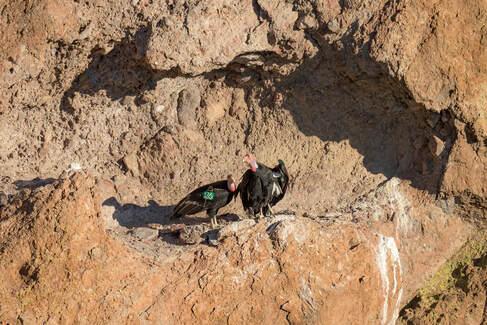 Two adult California Condors, who seem to be a mated pair by the displays that I saw, spend time together away from the rest of the flock in a perch inside of a cliff. Two adult California Condors, who seem to be a mated pair by the displays that I saw, spend time together away from the rest of the flock in a perch inside of a cliff. Camera Settings and Technique Nikon D500, 35mm, 1/500th sec, f/4.5, ISO 50, WB 5,550k I sometimes worry that I won't get any images while making a sizable trip to capture a species or landscape that I have my heart set on. But that's just the risk we as wildlife and conservation photographers run. The best we can do is prepare our asses off in hopes that we come back with at least one magnificent image, or maybe just an image that's meaningful to ourselves. This image to me is more meaningful than it is magnificent. I was already off hiking to the top of the pinnacles well before dawn to try and find the California Condors sun bathing in the first light of the morning. It was so cold that frost formed on my eye lashes in the first ten minutes of the hike. I relished it. If nothing else, the adventurous experience is worth the preparation. I remind myself to enjoy the journey as much as possible while in search of my dream to help California condors as much as possible throughout my career. I get to the top, round a corner (after rounding many corners hoping to see a glimpse of a condor), and there they are just a couple hundred feet away... a handful of them perched in what looks to be their roost and soaking in the sun. This is what I've been looking forward to! I spend time photographing them from a distance as not to bother their livelihoods. After all, I wouldn't want some stranger getting up close to me while I'm trying to do my thing either. More people more in eventually and they decide to leave the area. Besides, flying to different sites, carcasses to eat and clean up, there's work to do! I made my way up and around some cliff sides after I thought all the condors had moved on. I hiked into an area where I wanted to stuff my lunch down when I looked to the left and, to my amazement, there was one right there in front of me about 20 feet away. I couldn't believe this juvenile was just perched there still soaking up some sun, its head folded back on itself in a resting position. I took the moment to switch out my telephoto lens for my 35mm that I barely ever use anymore and position to get a shot with the landscape it regards as home in the background. 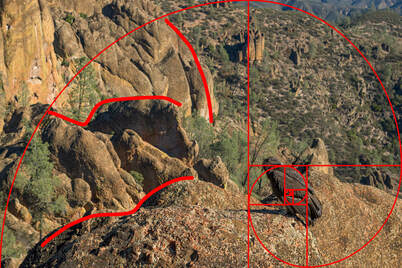 In-depth Study I'm really working on my composition right now. I have been getting better but my mentor, National Geographic Photographer Sirachai Shin Arunrugstichai (WARNING: his work can be very graphic) completed a portfolio review for me recently, and let me know I need more work. My point is, never be discouraged by the amount of work you'll have to put into creating great images. With this 35mm lens, I found it pretty difficult to compose the image correctly. One of the biggest keys to getting great images with the lenses you have is to practice with them constantly. This was not the case for me and my 35mm, which I felt like I should give another shot. And I'm glad I did because it allowed me to get the landscape and incorporate a condor that looks semi-close in the frame. I used the golden ratio composition to focus the condor in the frame. I also wanted the landscape to look more three-dimensional than the 35mm allowed, so I used three different sets of rock formations on the left to build a repeating pattern. The tops of the formations also became leading lines, which pointed towards my main subject. Ironically, the lines also look uncannily like the stripes that form the shell of a nautilus. It's a good image, not amazing, but good enough to print really big! I accomplished the composition I was going for to the best of my ability without stressing out the juvenile condor. Of course, I'm always thinking about what could have been better potentially. And then there are somethings that are out of my control. Ideally, this image would have been benefited from better natural lighting, rather than the flat, contrasting light of the early, cloudless afternoon.
2 Comments
"You must be shapeless, formless, like water. When you pour water in a cup, it becomes the cup. When you pour water in a bottle, it becomes the bottle. When you pour water in a teapot, it becomes the teapot. Water can drip and it can crash. Become like water my friend." -Bruce Lee This ONE SHOT entry is all about adaptability. If you've ever worked with forest light, you probably know how incredibly challenging it can be trying to capture subjects while generally compensating for both the darkest darks and the lightest lights. For me, normally I love to craft my images with a spectrum of deep darks and bright lights, and I don't mean just pumping contrast, but using my camera's customized color profiles to define the base of my style. If you don't know what I'm talking about, be sure to take the time to go into your camera's settings and look for wording similar to "Color Profile", but I digress. Camera Settings and Technique Nikon D500, 400mm, 1/320th sec, f/9, ISO 400, WB 5,650k In this case, I could not use my usual color profile selection because of the already intense, high-contrast setting in front of me. I instead used the setting called "Flat", which significantly evens out the light of an image, making shadows brighter and light darker. And this typically gives off a "cinematic" feel. Since I had to use a lower shutter speed compared to the 1/2,500th+ second I usually use for moving wildlife, I made sure to keep my camera and lens steady with a tripod and smooth gimbal head. It would have been great to get close shots with a wide angle lens, but in this case, it would have been illegal, not to mention disturbing to the butterflies if I had more or less chased them down. After all, what kind of person would I be if I thought my images are more important than the health of the wildlife I want to showcase and protect? 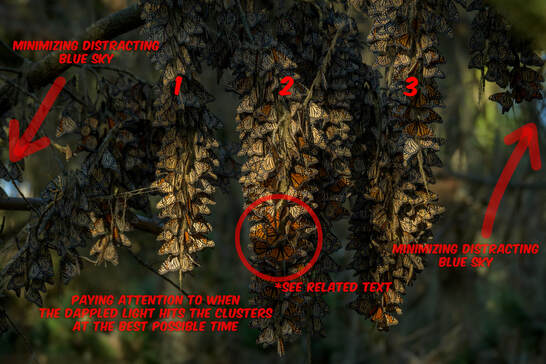 In-depth Study The very first thing I'm thinking about besides a good view of the Monarchs in a thick forest setting is the background. I want a dark background with the best negative space I can manage and minimized distracting blue sky. In this case, bright blue sky is the ultimate killer of the image I'm going for compositionally. Since the sky is brighter than the subjects, especially considering the significantly dappled, mixed forest light, the viewers' eyes will naturally gravitate towards the bright and high-contrast areas of the image, taking away from the image's true purpose. I also wanted the biggest clusters I could find and with an odd number of columns. An odd number of subjects in imagery always look better to our eyes than even numbers. Next, however long it might take, wait for the changing light to fall pleasingly onto your subjects, this could take a while. If you have even more time (or luck), try to also let the shadows of the background be as dark as possible while minimizing light in order to make your subjects stand out. *It would have been disappointing to capture these magnificent columns of butterflies without having at least some of them with their wings spread open, which also gives off the best impressions of orange colors, which is part of the reason why the Monarchs are so infamous. "You have to take risks. We will only understand the miracle of life when we allow the unexpected to happen." -Paulo Coelho Hi everyone! I've been saving this images for a few months now, waiting for it to be publicly released in Hakai Magazine. It's great to be able to finally review it and talk about why the editor's chose a peregrine falcon to be featured inside a coastal and marine focused magazine. Ironically, it was published under Hakai Magazine's One Great Shot, which has no relation to this blog. Peregrine falcons can be found in many environments: plains, deserts, forests, and even in cities where people are astonished as they look up to see the world's fastest animal diving from skyscrapers to hunt pigeons. But in North America, possibly the most important ecosystems for peregrines are ocean coastlines. Specifically, the Pacific Coast is an important migratory pathway for them, as confirmed by my friend and bird of prey researcher of over 20 years, Dan Varland.
Camera Settings and Technique Nikon D500, 400mm, 1/2000th sec, f/9, ISO 6400, WB 5,000k This time around, I'm going to talk a little about risk. I like calculated risk, wherein the probability of me succeeding is high after weighing out the odds. In this instance, in order to get the shot, I had to lean over the side of a cliff with thick gusts of wind and the awkward weight of the dSLR and telephoto lens in hand. Frankly, I took a risk with my life getting the shot of the peregrine falcon eating an invasive species of dove, but I knew I had some good physical balance on my side that I've learned over the years from rock climbing and long-distance mountain running. I also know this area well; its geography, its elements, and its dangers. That said, I do not suggest that you should risk your own life for shots. Another element that was crucial to getting the image was making sure that I was not a disturbance to the falcon. The safety of wildlife is never more important than our photography, or for our own curiosity for that matter. We all have our personal space bubbles, right? But in the case of most wildlife, their bubble is much bigger and more sensitive. It could have been easy to make this falcon feel uncomfortable and abandon her prey, which means she goes hungry. It also means that she has to spend the energy to to hunt a few more times, because a successful hunt happens only about once in every five tries or more. Either accidentally or, heaven forbid, intentionally scaring off a predator from its meal may mean it will starve to death. Not exactly ideal! It was respect that allowed me to get this image. And it will always be respect that will allow us to get images worth sharing. 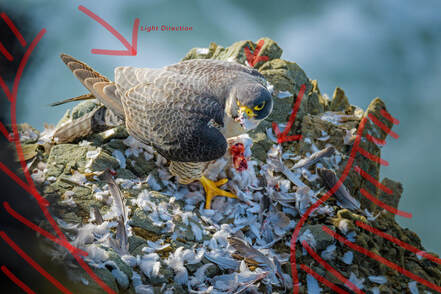 In-depth Study It's all about the light in this photo. Arguably, you could say that about any good photo, but it's especially true here for a number of reasons. The light needed be directional and bright, as opposed to flat and soft in order to convey the dimension of a cliff perch high above the ocean, as well as showing the beautiful form of the large falcon. The light also needed to come from exactly the direction shown in order to highlight the three-dimensionality of the scene by creating shadows that actually subframe the kill site. If it had come from behind the bird, it would cast a shadow towards my lens and light up the cliff, drawing more attention to the outside of the frame rather than the middle. From the right side, it would have casted a pretty favorable light on the falcon, but then the cliff would have again be lit up in addition to the ocean, creating less depth and dimension. If the light had come from behind, the cliff's shadow would have drown everything out. It's especially great that the light came from this direction at the time I was there because it was the only possible point to get the image from. I also liked how the peregrine's mouth was full of feathers and timed my capture so that the light was hitting her face when she turned her head towards me. And lastly, some simple leading lines in the form of the limestone rock jutting out from the cliffside help point towards the kill site. Are you looking for more info on peregrine falcons and their conservation success?
"Economic growth and environmental protection are not at odds. They're opposite sides of the same coin if you're looking at longer-term prosperity." -Henry Paulson So! I'm happy to say that I made the Top 100 in the NANPA (North American Nature Photography Association) Showcase Competition this year in the Conservation Category! My image is of a Threatened Western Snowy Plover mother shielding her rare and precious eggs from the rain--with human development in the background. One of the biggest threats to this species of plover is continued human development into beach habitats along the coastlines of California, Oregon, and Washington. Only about 2,000 of these little, tough badasses remain but with the help of organizations like Point Blue Conservation, who helped me get this image, they are repopulating slowly but surely! You can start to help the Western Snowy Plovers repopulate by keeping your feet, and perhaps your dog's paws, out of the roped-off protected areas on recreational beaches. It's not a suggestion, that's where they nest! Anyway, on with the study! Camera Settings and Technique Nikon D7200, 35mm (DX), 1/400th sec, f/8, ISO 400, WB 5,050k So how can you create a Top 100 Nature Photo in North America? You might not think it, but trust is definitely a technique. After all, this image would sure-as-hell not be possible without the trust earned between myself and Point Blue Conservation. Conservation photographers, if they are not already, are poised to be the greatest storytellers out of any photographic discipline in history, despite it being the newest photographic genre. The burden we carry to tell the hard-hitting and often emotionally upsetting stories of the current global mass extinction in order to sway public opinion into saving Earth’s ecosystem’s cannot be understated. Telling those stories about conservation, positive or negative, can't be accomplished without the help of conservation organizations. For an image like this one, an ethical photographer needs the permission of the people and organizations who are protecting a Threatened or Endangered species because the wildlife itself lives in a restricted area, in addition to being a bit more intrusive with the camera than normal. I absolutely love working with biologists and other such researchers. If you actually manage to earn their trust, it's guaranteed that they will share knowledge with you that only they know and will help you get the shots that are normally impossible to achieve. There is a combination of art, science, and conservation. It's an unmatched trifecta in visual storytelling for wildlife. However, I've heard too many times from biologists that they are willing to consider me working with them because I bring purpose, meaning, and an overall goal that helps conserve the wildlife with my images. So many photographers are in it for themselves and their portfolio. This is the wrong mindset entirely. If you're going to work with conservation organizations, you must set aside your own ego and personal goals, let go, and be willing to ask them how you can help them advance awareness for a species through your visual campaign. It's imperative to weave together your story with their goals. Yeah, it's not easy, but it's worth it! And if you're genuine and really want to help, I think it's really more fun than anything. The experiences are priceless and satisfying for both parties. Before you approach organizations, make sure you do you research about the species in question. Where do they live? What makes them special and uniquely suited to their habitat? Why are they under threat? Who are the key organizations and people involved with their rehabilitation and protection? How can you provide valuable creativity and documentation to them? Be passionate, open-hearted, and transparent about your intentions and curiosity. 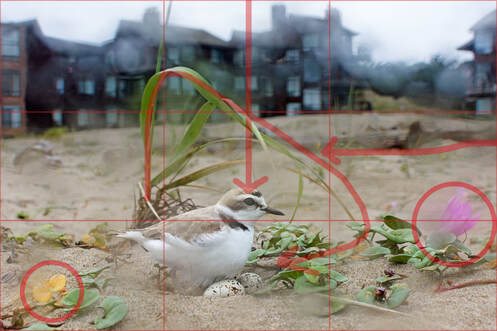 In-depth Study Sometimes, life gives us photographers almost exactly what we need in order to make a great shot that also possesses lasting definition. Thankfully, this is what happened here. Sure, the image isn't very vibrant, the light isn't good, the animal isn't particularly impressive at face value, and rain started pouring onto the lens, but the story is strong and seeing a mother coming in to protect her eggs is preciously rare. In fact, there is no other image like it of this species anywhere. It's entirely unique. Knowing that I had only seconds to set up my stationary camera after the biologist physically checked the health of the eggs, I quickly composed a shot with many elements that fortuitously lined up with each other. Before we approached the nest, I knew for sure that I wanted the human development in the background in order to tell that story of the way we humans are pushing our own expansion into every corner of the wild we can, forsaking the very beings that fully regulate the ecosystems our lives rely on. In general, it's the photographer's imperative to make sure that the health of the lives that we're photographing are more important than the images we create. In other words, as photographers, don't mess with the lives of the animals so that it changes their behavior. With this in mind, I have just about 60 seconds to set up a shot and leave the area while the biologist directs me safely through the habitat and alerts me to potential problems. And before that, we've already come up with a game plan and I have my settings ready and waiting. As I go to set down my stationary camera inside a custom weatherproof housing, I'm looking for a pleasing background and see the folded grass that humbly bows down into a subframe for the Western Snowy Plover and eggs. I also see a log laying down that points towards the subframe, which leads the eyes downward to the foreground. Then I see the pinkish-purple flower and the deep yellow leaf the contrast each other on opposite ends of the frame, further lending elements that suggest a deeper richness to the ecosystem. The flower is also just a really nice pop of color in a rather drab scene due to the overcast. They're also leaning away from each other... an interesting and subtle dynamic. There is no way on Earth that I wanted to get this aperture and focus wrong. I focused directly on the eggs and closed down my aperture to f/8 from f/1.8. I wanted to for sure maximize my depth of field on the subjects without introducing too much focus into the background. It was important to me to have clear separation of subject and background, rather than something like a wide-angle landscape with everything in focus from front to back. So, we quickly and carefully retreated about two hundred yards back, and we sat quietly, watching from our scope. A muffled camera and a remote trigger did the rest. In post processing, I also cropped in a bit to eliminate a bland, bright, and distracting sky while placing the center line to meet the eye of the mother. 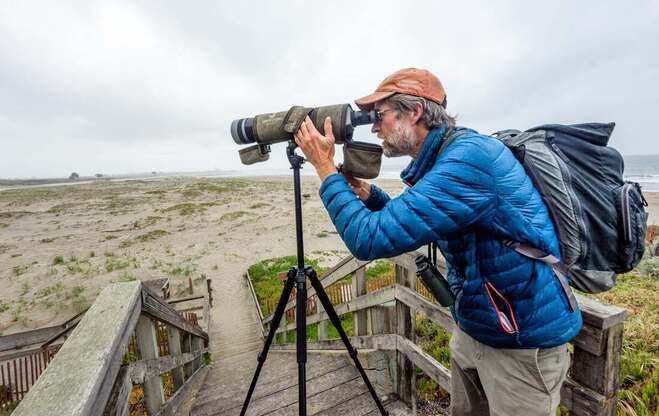 Biologist Carleton Eyster looks out for any signs of Western Snowy Plovers. He's also one rad dude; calm spoken yet adventurous and free spirited. Research and Conservation
Western Snowy Plovers are a bellwether species, meaning that they are indicators of a healthy habitat. It might seem impossible, but we could actually lose our beaches, and subsequently the wildlife, to coastal erosion caused by warming weather and rising tides caused by climate change. If there exists the plovers in an area, we can actually research and understand what makes such a beach habitat resilient to the active climate change happening at this very moment. From that, it's possible to create conservation actions that lead to the restoration and protections of coastal dune habitats so they do not disappear. All because of this one tiny species of hardy beach-dwelling bird. “Anxiety was born in the very same moment as mankind. And since we will never be able to master it, we will have to learn to live with it—just as we have learned to live with storms.” -Paulo Coelho, Manuscript Found in Accra Since the fires in Sonoma County, California are only ten miles away from me right now and this photo was made almost exactly three years ago during the first of the annual record-setting fires, it's fitting that I share this as the next ONE SHOT photo. Patience is a funny thing. We're waiting out the coronavirus. Waiting out the fire storms. And waiting out seemingly all of 2020 and probably beyond. The one thing we can't wait out is climate cancer--the catalyst for all of this. We need the impatience to brazenly help our dying home, and at the same time, we need the patience to see that reality through for our family, friends, their future families and friends, and so on. Climate cancer is what caused this images to be what it is; a hauntingly beautiful telling of our rapidly decaying Earth. It may look pretty normal, but take a look at the atmosphere. It's sunset, but there's no sun. What's actually there is a blanket of smoke made pinkish-purple and violet by the low-setting sun's penetration of the ozone layer. 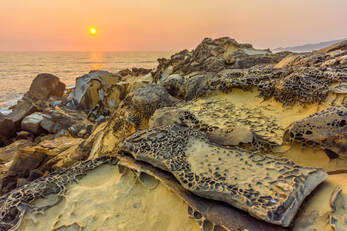 Camera Settings and Technique Nikon D7200, 12mm, 1/40th sec, f/13, ISO 100, WB 5,100k Landscape photography requires a different kind of patience than wildlife photography. Rather than scouting out prime locations for wildlife, your might be scouting for the perfect scene that captures an essence of the ecosystem. Finding a great landscape more often than not takes days of scouting and testing different angles before a photographer lands on what they define as the best scene. I've returned to Salt Point State Park more times than I can count. At the park's crown is a place where lava boiled up over the sea level and froze into place as large bubbles with smaller, inverted bubbles inside. There are also rarely seen limestone tafoni; a maze of tiny formations--like ripples in rock that were formed under the ocean about 50 million years ago. In the stillness of the rock formations is the indefinite presence of the swirling waves. While I thought the monochromatic scale and texture of the tafoni and sunset was interesting, what I really wanted to show was the juxtaposition between the seemingly unmovable and constant motion, and then also between my favorite contrasting colors of blues and yellows. The smoke from the fires came at a later date, which then produced the purplish atmosphere that complimented the blues. I love having contrasting colors in images, and if I can weave in some analogues colors into an image, even better. Those colors may be from either the hotter or cooler end of the spectrum, whatever nature gives in that moment. You might already know that tripods are nearly 100% necessary for landscape photography. Utilizing one enables a photographer to lower ISOs that effectively increase dynamic range, show truer colors, and increase sharpness. The high a photographer's ISO goes, the more all of that gets degraded. And very importantly for this type of image where I want to show water in motion, the camera has to be completely stable so I can drop my shutter speed down to about half a second or longer. I typically find that .5 seconds to 2 seconds is a really nice shutter speed range to start with for rivers or oceans. I also love putting standing seaweeds into my seascapes because they remain still unless affected by the ocean's currents and waves, which means the ability to see details in a subject, as well as motion.  In-depth Study This looks like a bit of a mess, but we are going to break the composition down and talk about the refining process of finding golden ratios then incorporating other compositional elements for a more eye-pleasing image. Keep an open mind! A person could make the case that not using the golden ratio compositional tool for landscape shots is borderline psychotic. It's a spiral based on a natural geometry found in nature (two of them can be seen to the right in the image). It also happens to be the most eye-pleasing shape in visual art. The origin of the spiral is what I want to place on either my main or secondary subjects. I also want to position my lens so that the actual line of the spiral lands on different, interesting physical elements, which helps the eye flow through the image easier. The bottom golden ratio lands directly on my main subject, the big rock covered with standing seaweed. The top one lands on the big rock jutting out from the right of the frame, it's a secondary subject that point towards the sky, and also breaks the boring horizon line, so the eye follows the purplish colors back counter-clockwise and back down into the ocean. From there, the waves take over, flowing around the rocks and on top of them, drawing further attention to the seaweeds. When you go back to look at the original image, can you feel your eye circling around the image, perhaps drawing attention to smaller details along the way? Wherever your eye happens to start, there should be a flow to the way your eye follows the rest of this scene. I use the closest rock in the image, the one I'm actually standing on with my tripod, to create an arrow that points into the rest of the scene and as a way to add more depth and dimension. Additionally, the textures of the rock combined with the yellow lichen adds some more "feel" to the image. You might be able to actually imagine what it feels like to reach out and touch it. Research and Conservation
Perhaps it's cliche by now, but the more time you spend getting to know an area, the better your odds at finding and creating an image that will make people stop to look. I spent a total of about two weeks spread out over a few months at Salt Point State Park. I made a lot of images and there was a lot of experimentation; flash, no flash? lava bubbles, no lava bubbles? Morning or evening? There was a lot of patience involved, but it's easy to be patient when the days spent outdoors are all just a bunch of fun. I surprised myself when I found that the best image was one that didn't really have tafoni or frozen lava bubbles in it. That's fun to say, lava bubbles. Anyway, although this gorgeous ecosystem is already protected, it is photos of beautiful and interesting ecosystems that can directly protect an unprotected ecosystem. Organizations that devote their resources to protecting wild lands, like the West Marin Environmental Action Committee, use images of natural habitats and the wildlife within to convince lawmakers to protect the very things being photographed. Even when they are protected, they can come under threat again from, what I'm going to strongly call, terrorists of nature, by proposing destructive plans, like for oil drilling, pipelines, mines, and other leech-like outdated methods of procuring energy from our one and only home. This when we as photographers need to keep battling against those types of destructive forces. By selling, or perhaps donating, your images to organizations that need them, you can find one way to become a conservation photographer... if you're not already! “There is only one thing that makes a dream impossible to achieve: the fear of failure.” -Paulo Coelho, The Alchemist ONE SHOT is about seizing the day and being prepared for it. Each feature focuses on just one main image and goes in depth with the settings, the techniques, and the journey. Wildlife photography is a difficult art form, precisely because we, as photographers, never know if we’ll actually find the wildlife we’re looking for. We might try our absolute hardest to guarantee positive results, but I think we all know that sometimes our days end with lessons about not forgetting how to be in the moment. That’s why I created ONE SHOT, so when that rare opportunity to photograph an amazing scene happens, perhaps it’s even the shot of a lifetime, this will help nudge you into a more prepared direction. Thankfully, I’ve been afforded some amazing opportunities to photograph wildlife, like in the sub-zero temperatures of the ancient and volcanic High Andes, Argentina to the underwater ocean world of sea grass plains and kelp forests right here in my home state of California. Those experiences combined with help from some incredible people has led me to become sponsored by Nikon USA and with some good publications under my belt. And that whole time, spoiler alert, I’ve been messing up. Maybe you can relate to this: I’ve forgotten memory cards, input the wrong camera settings, not been prepared for changing weather, fell sick or injured while in-the-field, even burned bridges with people. In other words... failing. So let’s put the classic, positive spin on it--failing helps recognize weaknesses in ourselves and leads us on a path to become stronger photographers and overall human beings--embrace it. Beyond forgetfulness or having the wrong settings, we need to fail creatively through experimentation so we can grow infinitely. Now let’s look at how we can approach wild animals and our cameras the right way to create the best possible outcomes for our wildlife photography using classic techniques in this post-modern era. Settings 1/2000th sec, f/7.1, ISO 500, 500mm, WB 5,250K Quickly, I have to thank a great and trusted wildlife photographer who tipped me off to the Black Skimmers, a specialist of urban environments, Jouko van der Kruijssen. These birds are rare visitors to the San Francisco Bay Area and since the moment I learned about their existence, I’ve wanted to photograph them. Skimmers have a unique hunting style found in no other species on Earth. Their lower mandible is much larger than their upper, which they use for dipping into the water while flying at high speeds to tactfully snatch up any unsuspecting fish. When Jouko told me about their local presence, I leaped at the opportunity to photograph them. It’s critical to waste as little time as possible when you hear about wild animals you want to photograph, especially if it’s a migratory species like this one; who knows how long they are going to be around! Now being there, I knew that to really capture the skimmers in the moment, I would have to use a fast shutter speed, as is the case with most birds in flight. For a great freeze-frame, where even the wingtips are frozen in place, 1/2000th of a second is the lowest shutter speed I want to use. However, I recommend pumping up your speed to anywhere from 1/2500th to 1/8000th of a second if there is just that much good light or your camera can afford handling higher ISOs. Gathering light in this situation is also paramount. A telephoto lens that gives you f/2.8 or f/4 aperture for some awesome light gathering means faster shutter speeds, but the wide-open aperture also acts as a way to reliably separate the subject from the background and foreground. Alternatively, I know by closing 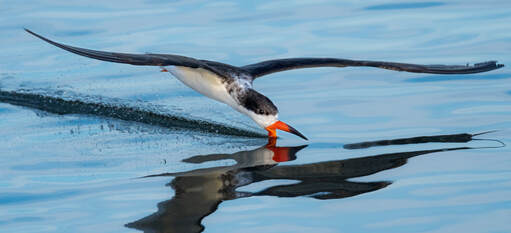 my aperture slightly to f/8, my camera will give me the sharpest images at the cost of gathering light. If there is great light, f/8 is a completely viable option in my book and it will open the depth of field (DoF) slightly deeper for more detail in my feathered friends, which I love. It’s not just the eyes that are captured, but also perhaps the full beak, wings, feet, and tail feathers. Keep in mind that the closer the subject is to your lens, the smaller the DoF is. Since the Black Skimmer was generally flying very close to me while hunting, the DoF was tiny. So, I closed my aperture to counteract the chance of loosing critical detail in the skimmers face and wings. Ultimately, with the fading light, I decided to use an f/7.1 aperture so I could gather enough light to use my minimum requirement of 1/2000th of a second. Technique The key to photographing birds in flight successfully is to predict their flight path and have eyes in the back of your head. When I got to the location, I learned fast that these Black Skimmers fly swiftly with purpose and sometimes like to “thread the needle.” In all the time that I watched them, whenever they took off, that meant it was their intention to go hunt. In flight, they make big, sweeping gestures and then without wavering, dive at the water’s surface and suddenly break off before hitting it, barely skimming above with their lower beak dipping in, feeling for fish. I knew I would apply the same technique to photograph this species as I do with capturing raptors. Holding your camera and lens in hand, brace your arms by firmly tucking your elbows into your body and then rotate your torso at the hips, following the direction and speed of the animal. Don’t forget to hold your breath as well, that will minimize the shake of the camera. Sometimes I love to have my subject backlit for a nice glow along the edges of the animal, but in this case, I wanted to show off all the glorious detail of the hunt. So, I made sure the sun was at my back while I tried to keep the bird in front of me. Now work the scene as much a possible to develop a strong image. Sometimes my ego tells me, “Hey, you got enough shots.” Wrong. Ego is always wrong. You can almost never have enough shots as long as the animal is comfortable with your presence. More time spent = more opportunities for creative shots. Since I had the opportunity to spend the last few hours of light photographing the Black Skimmers, I experimented with different settings, angles, and took time to really study their lives, which brought me closer to achieving an impressionable and award-winning shot. That’s one of my goals, after all. 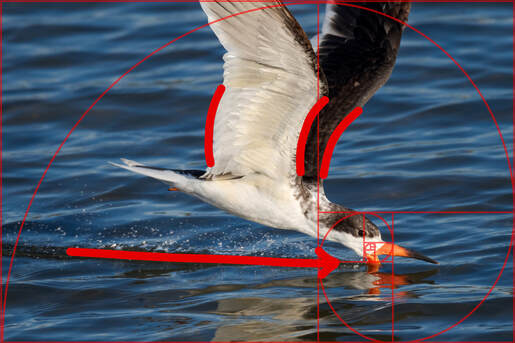 Bonus Study It wasn’t too long after I started photographing the Black Skimmers’ hunting techniques that I realized the water streak they create can be used as a leading line to draw the eyes towards the “hero” of the image, which is the flashy orange beak that also shows off as a unique and useful biological feature. Then I placed the beak as close to the golden ratio origin as possible, which creates a satisfying, pleasing composition. There’s also something nice about the slight pattern of the lower wings and how each wing also contrasts from each other in color. When it came to the background, I tried to position myself to have the water reflect as little light as possible, which can look ugly and often distracts from the rest of the image. And I’m going to cap this with a little self-critique. In hindsight, I would have used a faster shutter speed at the cost of a higher ISO to freeze the water droplets better in place. Research
It’s important to study up on the species you’re about to photograph. The more a photographer knows about their wild subject, the better the feel for what happens when it comes to photographing that animal. This includes being able to read the warning signs of a particular species, which will help you make the right, ethical decisions to keep safe what we love to photograph. If the presence of any one of us impacts any wild animals ability to live, it’s important to make the right decision to immediately back off. Our photos are never more important than the health of the animals we photograph. |
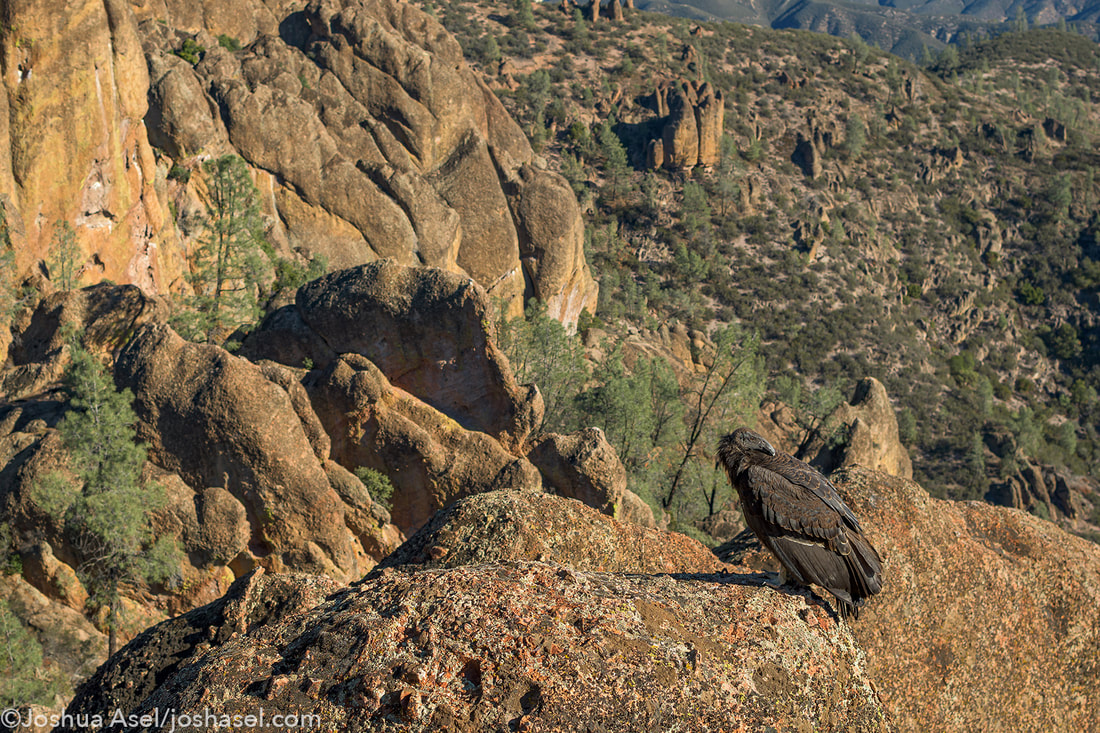
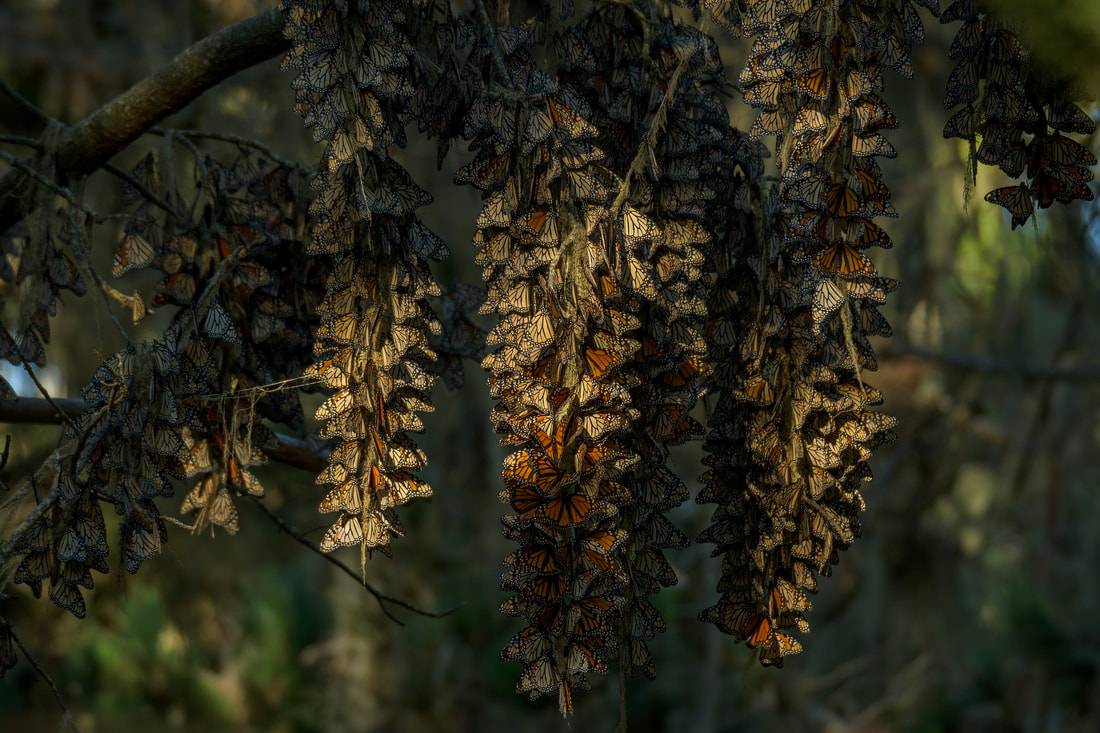
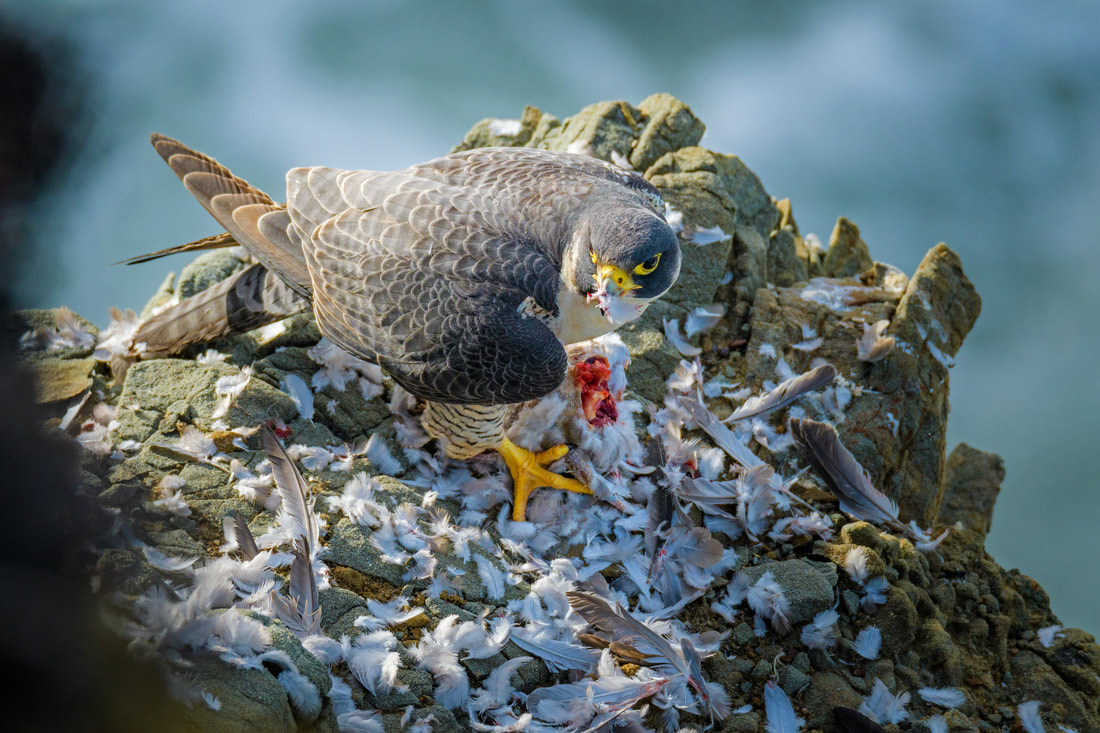
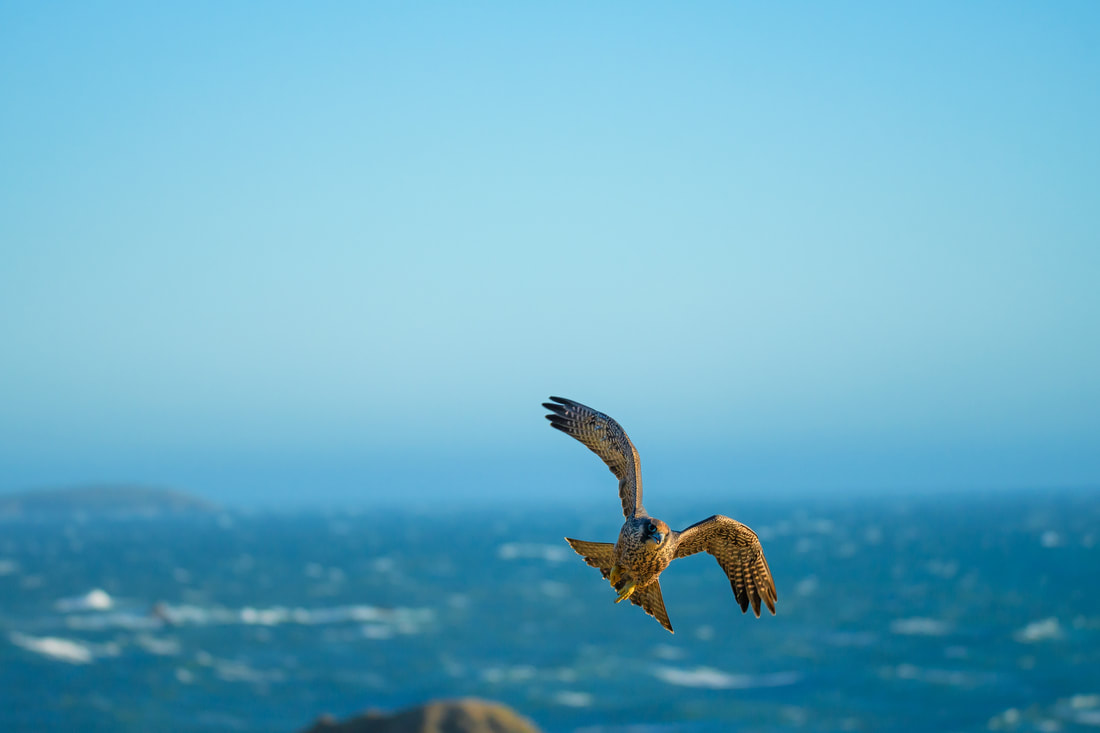
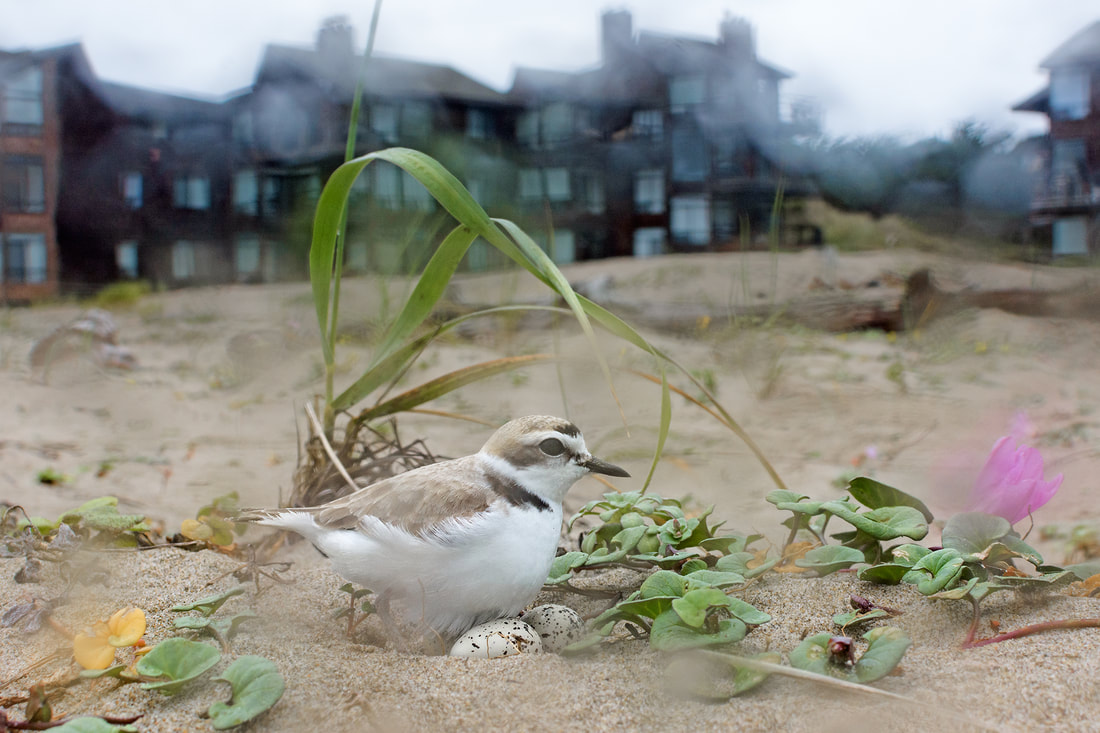
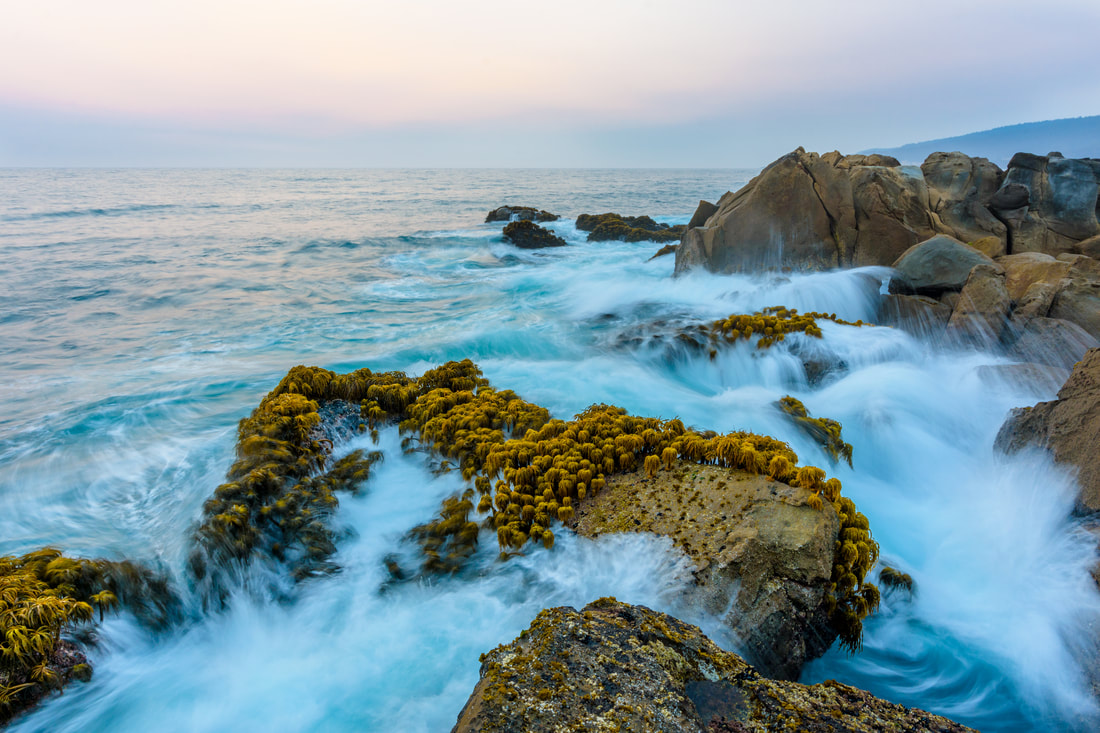

 RSS Feed
RSS Feed